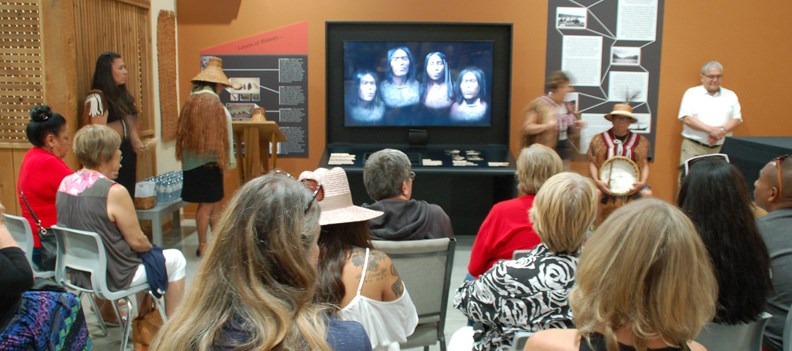On the same day Canadians celebrated 150 years since Confederation, the shíshálh Nation honoured their 4,000-year-old ancestors with an official preview of the Face-to-Face exhibit at Tems Swiya Museum.
Following drumming and song, museum curator Racquel Joe introduced the centrepiece of the exhibit – a module displaying digital facial reconstructions of four high-status adults whose remains were excavated near Salmon Inlet starting in 2010. As she did so, Joe addressed her fellow shíshálh members sitting among the audience of invited guests.
“Their blood is running through all our veins,” she told them.
“So this is us, 4,000 years ago.”
Joe also unveiled showcases containing artifacts discovered in the burial sites, including one case holding more than 350,000 stone and shell beads – “enough to fill a modern bathtub.”
During speeches outside the House of Hewhíwus complex, University of Saskatchewan archeologist Terry Clark explained the significance of the find.
“The chiefs buried here are some of the most elaborate burials known in North America. The four adults we recovered were all richly adorned with ground stone and shell beads, jewelry, artifacts and ochre,” Clark said.
“Four thousand years ago, these ancestors could have been some of the most powerful people in all of North America, and they were found here. They were shíshálh people.”
The reconstruction project was a three-year collaboration with the Canadian Museum of History and underwent dozens of rounds of changes, Clark said, based on feedback from elders and other members of the shíshálh community.
“These reconstructions were done in Paris, France by the world’s leading digital forensic expert [Philippe Froesch]. He’s used to working on the kings and queens of Europe and I think that the shíshálh chiefs have every place alongside the people he’s worked on in the past.”
An identical module opened on the same day at the Canadian Museum of History near Ottawa – the country’s largest – and an estimated 30 million people will see the exhibit over the next 20 years, Clark said.
Other speakers thanked the many people who had been part of the project, which dated back to 2001 when current councillor Keith Julius, working with archeologist Peter Merchant, first spotted evidence of a burial site.
“My hands go up to all the staff,” Chief Warren Paull said. “My hands go up to all the people who made this day.”
Director of culture Steven Feschuk, son of former chief Garry Feschuk, who attended the event with his wife Pauline, said the project succeeded in doing justice to the ancient chief – “who he was and the time he came from” – in order to educate the shíshálh and the broader community.
“Our teachings usually tell us to leave and respect our ancestors in the ground,” he said. “But we have a reason. He’s here because he’s teaching us. His influence is evident by the beads and by the wealth he had … but if you look at it – 4,000 years and he’s still helping our communities, he’s still teaching us.
“This person is here to help us all to live together.”
The exhibit, “kw’en-usitsht tems stutula (we are face-to-face with our ancestors),” opened to the general public on July 4. Tems Swiya Museum is located at 5565 Sunshine Coast Highway in Sechelt.
See more photos in our online galleries at www.coastreporter.net



